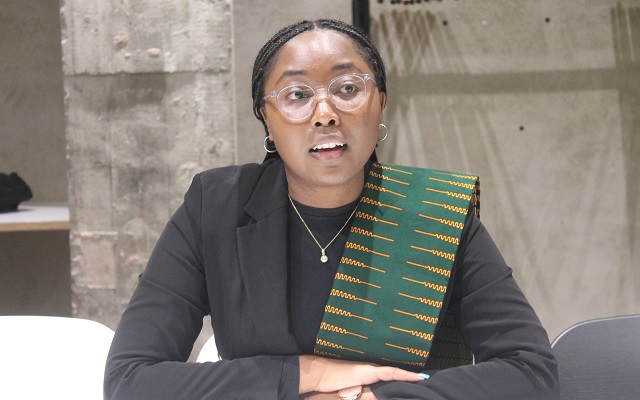
Tallinn, Estonia | Emma Inamutila Theofelus, Namibia’s Deputy Minister of ICT attended this year’s e-governance conference in Tallinn, Estonia, which was held May 30-31 under the theme: “Digital Innovation as catalyst for social change.” Shortly after the conference, she shared her views in an interview with the AU-EU D4D Hub media fellows about the e-governance agenda in Namibia and the African continent. The Independent’s RONALD MUSOKE captured her views.
What’s your take away from this year’s e-governance conference?
My take away is that we (first) need to win the citizens’ trust if we are going to successfully implement e-e-government programmes. We need to be as open and transparent as possible to our citizens so they understand what we are trying to do and hopefully that will cultivate trust; that they will trust us with their data and their lived experiences so that we can tailor the services to their needs. If we don’t do so, then we might get some resistance.
What, in your opinion, does your government need to do more to build citizens’ trust when it comes to the digital transformation agenda?
In Namibia, the Minister of ICT is the official government spokesperson and imparts communication of government programmes and activities. Last year, the Namibian Parliament passed the Access to Information Act, an enabler for accelerating the way the government imparts information to the public with a very consultative approach. For instance, the Ministry of ICT recently announced that they have now ensured that people can register to acquire national identification documents (national ID, passports or any other form of identity) online. We see this as an opportunity to digitally transform Namibia. In March, this year, we had a delegation from Estonia visit Namibia and we had a vigorous communication exercise for Namibians to understand that we are going to sign a memorandum of understanding with Estonia and that these are the services we are planning to bring online. All this is geared towards preparing the nation bit by bit, every single step of the way to say that we want to digitally transform Namibia.
We really got a lot of lessons during COVID-19 and learnt a lot how better to communicate to our citizens to prepare them for change. This is why we are continuously putting it out there that we want to move towards digital transformation; that at some point, it will require one to give up their physical ID for an e-ID. I think Namibians are generally receptive but we are also doing our part in gradually preparing them for the change that is coming.
During your panel session, you painted a picture of Namibia being a huge country with sparse population but also with a big portion of the country being “harsh” in terms of terrain and climate. How do you think your government’s digitalization roadmap could help Namibians sidestep some of these challenges and improve their lives?
Namibia is about 825,000 sq km large with a population of about 2.5 million people that are quite dispersed. We have two deserts (the Namib and Kalahari) and most of the country is arid. So, rolling out ICT infrastructure is extremely expensive. Because people are sparsely populated; you will often get communities of just 200 people that you need to connect to the electricity grid, water or even set up a mobile network tower for. But we see opportunity through bringing services closer to people via digital platforms; that they can go beyond accessing government services physically but also virtually. We saw during COVID-19 that our previous strategy of connecting every rural school and healthcare facility to network connectivity as a priority before rolling it out to nearby villages (probably had some flaws). When everybody left and was stuck in their household, we now had people who were less connected in the household than in the schools when the children were in schools. Now, our strategy has changed to see how best we can roll out infrastructure in a way that regardless of a crisis, everybody stays connected. We have also got a lot of engagement with satellite companies in the last few months and many applications are still with the regulator (Communications Regulatory Authority of Namibia) to really ensure that we are able to connect every citizen to the last mile. The ability for someone to get their ID so that they can connect to the welfare system is crucial. In Namibia, we have a very good welfare system; when citizens turn 60, they get their pension; orphans and vulnerable children get grants and so do people with disability. But that requires identification. We want all these services to get online so that people do not get left behind in terms of time and benefits.
What came out during the conference is the idea of leaving no one behind. What’s your position on the issue of women in this digital transformation agenda not only in Namibia but also across Africa?
This is a very important question because in most cases women continue to be left behind especially in the area of digital connectivity while in the area of digital skills and literacy, women continue to be the biggest demography that is unskilled and illiterate. Namibia, for example, has embarked on a digital literacy programme through our rural ICT centres because we understand that the divide widens in the rural parts of the country. We have 26 ICT rural centres where we are rolling out a programme with a clear focus on marginalized women. Our ICT Ministry has also in the past put together a programme for coding in collaboration with the United Nations Economic Commission for Africa (UNECA) to teach girls how to code. On a broader continental scale, there are various groups that are eagerly looking at ensuring that we have digital justice on the continent. I am a member of an organization called the Nala Feminist Collective Council. It is spearheading digital justice as a means to bring connectivity and digital skills to women across the continent. We will be having our summit in July this year in Nairobi. Our focus is on how women can leverage the internet and digital skills to improve their lives through economic activity, through education access and other areas they are left behind on.
Is Africa ready for the global digital transformation agenda?
I have had this question asked (even) in Namibia; people have been asking why am I pushing the digital agenda when people don’t have basic services but I see it this way: When Europe transformed to mobile phone connectivity, Africa did not have to go through the same painstaking phases that Europe went through to get the mobile technology, connectivity and penetration that we have today. If at the time we had had the same discussion; that Africa should not have mobile telephony because people lack basic services, where would we be at this particular moment? I don’t think we should ask that question any longer. We have to be ready because if we are not ready, we will be left behind. We don’t have a choice. We need to be ready if we are to achieve programmes like the Africa Free Continental Trade Area (AfCFTA). Estonia has demonstrated that it is possible. They are a small country with a small population with very few resources and yet they have managed to do something with the digital agenda. Surely, Africa with its mineral wealth, young population and vibrancy can definitely have this digital transformation.
Your government has this ambitious digital transformation agenda but how much can you do by yourself if your neighbours are not as ready?
There is actually much we can do without some synergies from the region like the Southern African Development Community (SADC) or the continent. Estonia has shown us a good example. They didn’t need anybody; whether the neighbouring countries or even Europe; to explore and test some of the systems they were able to implement. In many instances, many countries have shown that they simply go ahead and the rest follow. South Africa, for example, was the first to adopt 5G technology just recently and almost every SADC member has adopted 5G except for Malawi.
Namibia, like many other African countries, is facing some economic hardship yet the government is determined to push on with this expensive digital transformation roadmap. How are you ensuring that the digitalization agenda remains at the forefront amidst the government’s competing development priorities?
President Hage Geingob has put together a 4th Industrial Revolution Task Force to look at how best they could accelerate Namibia’s digital transformation journey. So, in terms of political will, right from the highest office, it has been demonstrated that it is a growing priority. However, in terms of putting the dollars to match, that requires us to have a proper roadmap of where we want to go and how we want to do it. This is why we are constantly leaning on Estonia to learn about their journey so that we don’t waste taxpayers’ money; that we have a better roadmap that will guide us to actually roll-out our digital transformation in a more cost-effective manner.
Where do you see Namibia over the next 15 years as it walks its digital transformation journey?
We would have achieved our Vision 2030 and probably come up with a new digital vision for the country that will probably have a digital element that our forefathers had not thought about in the current Vision 2030. With a citizenry that today is 60% under 30 years, I would expect it in the next 15 years to be digitally connected, digitally literate, have the ability to run e-commerce businesses without any limitations and also have the ability to tele-work (live in Namibia but work anywhere in the world); and have the ability to shape solutions for Namibia’s problems with the help of technology.
Your last word?
I am very happy that my government was able to send me to this e-governance conference to study the Estonian e-governance successful journey. It’s a journey that Namibia has decided to embark upon. The journey is expected to be very long. We don’t expect to see changes overnight. We are a unique country with unique challenges but also unique opportunities. We understand that it will not be perfect, we understand that we will not be able to reach the heights Estonia has achieved very quickly but we know that this journey will be valuable for us as a government and for our people and it will form part of one leaf in the book of Namibia’s developmental journey.
*Reporting at the e-Governance Conference in Tallinn, Estonia, was made possible thanks to the travel support of the AU-EU Digital for Development (D4D) Hub
 The Independent Uganda: You get the Truth we Pay the Price
The Independent Uganda: You get the Truth we Pay the Price


